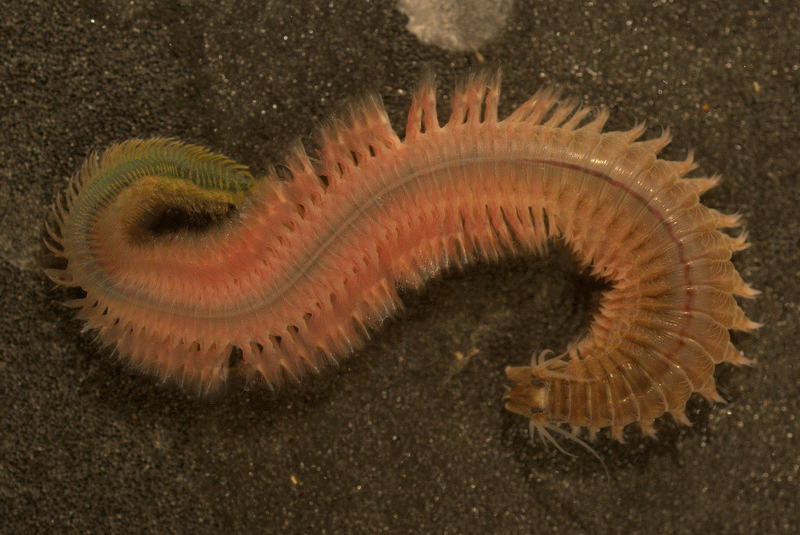"Had to change up my jigs," said my friend Shawn Kimbro. "Mayworms have been swarming the last couple of nights, and the rockfish are gorging on 'em. The fish are stuffed, but they're still eating. I've switched to small, red or pink jigheads and five-inch bodies. I start the lures on the bottom, but I work 'em up through the water column, since the worms come out of the mud and swim all the way up to the surface." Another friend, Skip Zinck, also "matches the hatch", this time trolling a wire "umbrella rig" of multiple small red tubes to simulate a swarm of worms emerging from the bottom.
Observant anglers make good naturalists. Neither Shawn nor Skip is a trained biologist, but both can "think like a fish," adjusting to seasonal rhythms like the "Mayworm" hatch. What they are watching is the annual mating rituals of Neanthis succinea, the clamworm. Benthic ecologists (scientists who study Bay bottom communities) describe the clamworm as a deposit feeder, a scavenger literally eating its way through underwater soils in a way like what earthworms do for land. The worms' digestive tracts break down and absorb bits of decaying organic material, passing the rest out behind as the worm moves. They also prey on tiny crustaceans and smaller worms that they encounter. This way of life allows them to adapt to a variety of growing conditions, including temperatures, salinities, and foods. No wonder they are widely distributed in saltwater environments around the Earth. They form burrows to live in anything from soft mud to debris on an oyster reef, but they also crawl out and around, exploring for food.
The swarming behavior is mass reproduction. In early spring, males and females begin to develop spawning organs and enlarged bristles along their bodies for swimming. Males also turn a brighter shade of red, especially in their mid- and lower bodies. Under the right conditions—water temperatures in the upper 50s and 60s on nights around the new moon (June 13 this year)—female clamworms in the bottom exude a pheromone that triggers males to leave their burrows and begin releasing sperm into the water as they swim in small circles toward the surface. That triggers the females to emerge, swim along with the males, and begin releasing eggs that the sperm fertilize. The swarm becomes a frenetic dance that a human observer may be able to see in the beam of a flashlight on a dark night, out in a boat or walking along a pier. After several nights of swarming, the adult worms die, while the larvae they leave behind join the local plankton community for a few days before turning into tiny worms and dropping to the bottom to start the cycle over.
Clamworms belong to a huge (more than 10,000 species), diverse, mostly marine class of segmented "bristle worms" whose numbers speak to the success of their basic design. Worldwide, the polychaetes fill critical food web niches in their ecosystems, converting decaying material and tiny animals into their flesh and in turn feeding a wide range of predators. In the Chesapeake, that predator group ranges seagulls, herons, and shorebirds to a dozen species of crabs and virtually every fish more than a couple of inches long that feeds on the bottoms of the Bay and its rivers. No wonder that bloodworms (multiple species of the genus Glycera) are always in high demand among Bay anglers, though most of the big ones sold here get shipped in from diggers on mud flats in New England.
The clamworms may be the most obvious members of the Chesapeake's polychaetes, but life in the Chesapeake Bay lists more than two dozen species of bristle worms indigenous to our waters. Want to see some? You don't have to be an angler to find them. Sift through a shovelful of bottom sand or mud, or look closely at clusters of oysters that have just come out of the water. Or shine a flashlight from a pier at evening around the new moon. And smile as you do. Our Bay's worms are cornerstones of its ecological wealth.
For more happenings on the Bay this month see our Chesapeake Almanac podcast.




